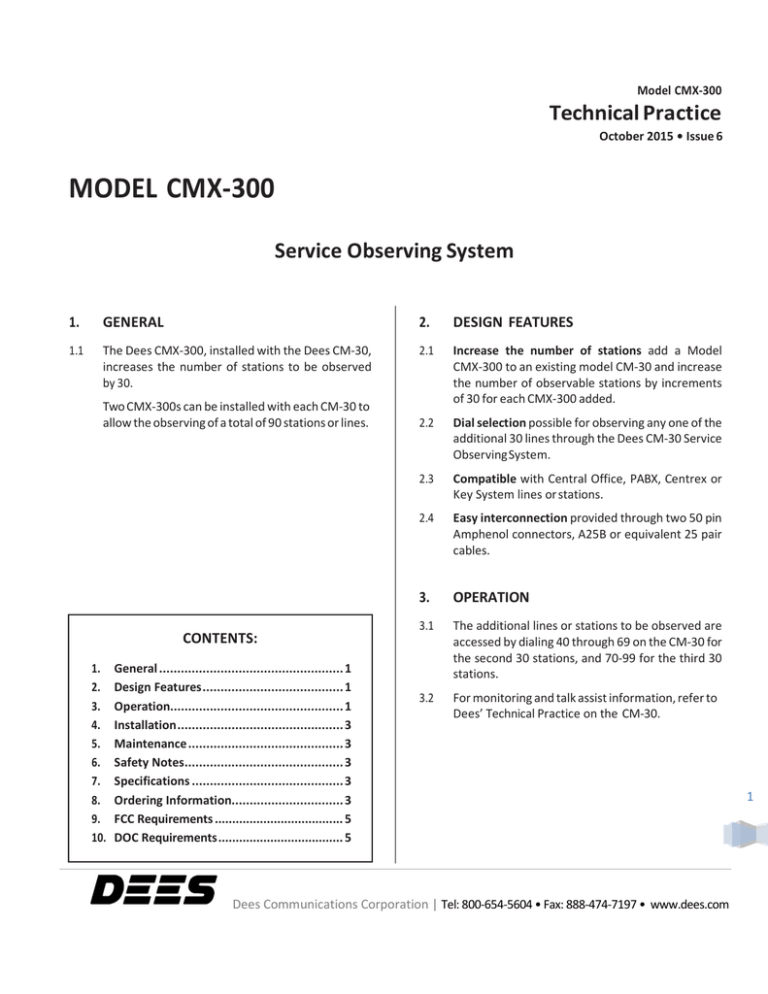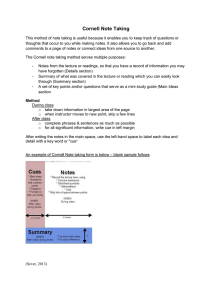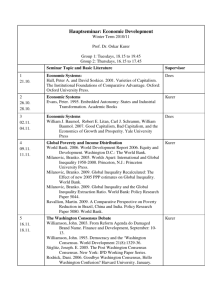model cmx-300 - Dees Communications
advertisement

Model CMX-300 Technical Practice October 2015 • Issue 6 MODEL CMX-300 Service Observing System 1. GENERAL 2. DESIGN FEATURES 1.1 The Dees CMX-300, installed with the Dees CM-30, increases the number of stations to be observed by 30. 2.1 Increase the number of stations add a Model CMX-300 to an existing model CM-30 and increase the number of observable stations by increments of 30 for each CMX-300 added. 2.2 Dial selection possible for observing any one of the additional 30 lines through the Dees CM-30 Service Observing System. 2.3 Compatible with Central Office, PABX, Centrex or Key System lines or stations. 2.4 Easy interconnection provided through two 50 pin Amphenol connectors, A25B or equivalent 25 pair cables. 3. OPERATION 3.1 The additional lines or stations to be observed are accessed by dialing 40 through 69 on the CM-30 for the second 30 stations, and 70-99 for the third 30 stations. 3.2 For monitoring and talk assist information, refer to Dees’ Technical Practice on the CM-30. Two CMX-300s can be installed with each CM-30 to allow the observing of a total of 90 stations or lines. CONTENTS: 1. 2. 3. 4. 5. 6. 7. 8. 9. 10. General ................................................... 1 Design Features ....................................... 1 Operation................................................ 1 Installation .............................................. 3 Maintenance ........................................... 3 Safety Notes............................................ 3 Specifications .......................................... 3 Ordering Information............................... 3 FCC Requirements ..................................... 5 DOC Requirements .................................... 5 Dees Communications Corporation | Tel: 800-654-5604 • Fax: 888-474-7197 • www.dees.com 1 Connections from CMX-300 to CM-30 and lines to be observed Fig. 1 Page 2 DEES MODEL CMX-300 4. INSTALLATION 5.3 4.1 Special installation tools are not required. Mount the CMX-300 near the CM-30 in an apparatus cabinet, relay rack or on the wall. Connect the CMX-300 through two 25 pair connector cables and secure them with the clamps and screws provided. The CMX-300 is warranted against defects in manufacturing and material. Refer to DEES’ Warranty, Service Policy. 5.4 For technical assistance on the CMX-300, contact DEES. 4.2 Cross connect as shown in figure 2. 6. SAFETY NOTES 4.3 The lines or stations to be monitored are accessed by dialling numbers 40-69 (1st CMX-300) or 70-99 (2nd CMX-300). Connect the tip and ring of the lines or stations to be monitored to the input pair terminated on the connecting block and designated TAO, RAO, to TC9, RC9. 6.1 Never install telephone wiring during a lighting storm. 6.2 Never install telephone jacks in wet locations unless the jack is specifically designed for wet locations. 4.4 Tie T and R of CMX-300 to TX and RX of CM-30. 6.3 4.5 Tie RO-R9 of CMX-300 to RO-R9 of CM-30. Never touch uninsulated telephone wires or terminals unless the telephone line has been disconnected at the network interface. 4.6 For stations 40-69 of CMX-300 tie AXFR, BXFR and CFXR to R4X, R5X, and R6X of CM-30. 6.4 Use caution when installing or modifying telephone lines. 4.7 For stations 70-99 of second CMX-300 tie AXFR, BXFR and CFXR to R7X, R8X and R9X of CM-30. 4.8 No power connections are required on the CMX-300. 7. SPECIFICATIONS Operating temp:.....................................................32˚ to 122˚ F 0˚ to 50˚ C Operating humidity:.....................................................0 to 95% non-condensing Breakdown volts observed lines to ground: .................................................................1,000 VDC max Connections: ...two A25B or equivalent 25-pair connector cables Dees Model CMX-300 Mounting: ......apparatus cabinet, relay rack or backboard Dimensions:.......................9.25” x 5.40” x 1.58” (L x W x D) Weight: .............................................................................1.9 Ibs. 5. MAINTENANCE 5.1 No provisions are made for field adjustment or repair of the CMX-300. If the CMX-300 does not operate properly, verify connections and check the cable plugs and connectors for proper contact pressure and cleanliness. 8. ORDERING INFORMATION 8.1 Order as follows: If after thoroughly checking cables and connections, the CMX-300 still does not operate properly, test the unit by removing the cables and reconnecting them to a substitute CMX-300 known to be functional. 8.2 5.2 DEES MODEL CMX-300 CMX-300 SERVICE OBSERVING EXPANDER from your local supplier or distributor. For further information, applications engineering or technical assistance, contact: Dees Communications Corporation 1-800-654-5604 Page 3 CMX-300 Cable Connections Fig. 2 Page 4 DEES MODEL CMX-300 FCC REQUIREMENTS TYPE OF SERVICE Your CMX-300 is designed to be used on standard device telephone lines. The CMX-300 connects to the telephone line by means of a standard jack called the USOC RJ21X. Connection to telephone company-provided coin service (central office implemented systems) is prohibited. Connection to party lines service is subject to State tariffs. TELEPHONE COMPANY PROCEDURES The goal of the telephone company is to provide you with the best service it can. In order to do this, it may occasionally be necessary for them to make changes in their equipment, operations, or procedures. If these changes might affect your service or the operation of your equipment, the telephone company will give you notice, in writing, to allow you to make any changes necessary to maintain uninterrupted service. If you have any questions about your telephone line, such as how many pieces of equipment you can connect to it, the telephone company will provide this information upon request. In certain circumstances, it may be necessary for the telephone company to request information from you concerning the equipment which you have connected to your telephone line. Upon request of the telephone company, provide the FCC registration number and the ringer equivalence number (REN) of the equipment which is connected to your line; both of these items are listed on the equipment label. The sum of all of the REN’s on your telephone lines should be less than five in order to assure proper service from the telephone company. In some cases, a sum of five may not be usable on a given line. IF PROBLEMS ARISE If any of your telephone equipment is not operating properly, you should immediately remove it from your telephone line, as it may cause harm to the telephone network. If the telephone company notes a problem, they may temporarily discontinue service. When practical, they will notify you in advance of the disconnection. If advance notice is not feasible, you will be given the opportunity to correct the problem and informed of your right to file a complaint with the FCC. In the event repairs are ever needed on your CMX-300, they should be performed by Dees Communications or an authorized representative of Dees Communications. For information contact: Dees Communications Corporation Tel: 1-800-654-5604 support@dees.com www.dees.com DOC REQUIREMENTS EQUIPMENT ATTACHMENT LIMITATIONS NOTICE The Canadian Department of Communications label identifies certified equipment. This certification means that the equipment meets certain telecommunications network protective, operational and safety requirements. The Department does not guarantee the equipment will operate to the user’s satisfaction. Users should ensure for their own protection, that the electrical ground connections of the power utility, telephone lines and internal metallic water pipe system, if present, are connected together. This precaution may be particularly important in rural areas. Before installing this equipment, users should ensure that it is permissible to be connected to the facilities of the local telecommunications company. The equipment must also be installed using an acceptable method of connection. In some cases, the company’s inside wiring associated with a single line individual service may be extended by means of a certified connector assembly (telephone extension cord). The customer should be aware that compliance with the above conditions may not prevent degradation of service in some situations. Caution: Users should not attempt to make such connections themselves, but should contact the appropriate electric inspection authority or electrician, as appropriate. Repairs to certified equipment should be made by an authorized Canadian maintenance facility designated by the supplier. Any repairs or alterations made by the user to this equipment, or equipment malfunctions, may give the telecommunications company cause to request the user to disconnect the equipment. DEES MODEL CMX-300 This digital apparatus does not exceed the Class A limits for radio noise emissions from digital apparatus set out in the Radio Interference Regulations of the Canadian Department of Communications. The Load Number (LN) assigned to each terminal device denotes the percentage of the total load to be connected to a telephone loop which is used by the device, to prevent overloading. The termination on a loop may consist of any combination of devices subject only to the requirement that the total of the Load Numbers of all the devices does not exceed 100. Page 5 Page 6 DEES MODEL CMX-300



